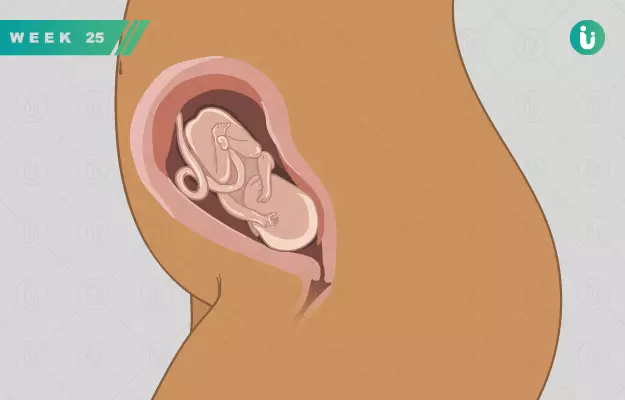Welcome to the 25th week of pregnancy! You’re nearing the end of the second trimester, and your baby should be thriving right now. Your baby bump has not only been growing, but now that your baby is active and you can feel him or her moving, you’ll actually be able to interact with your little bundle of joy in a way.
There are no foetal ultrasounds you need to get done this week, but make sure to ask your doctor about getting your blood sugar levels and cervical strength checked. This is because gestational diabetes usually shows up between the 24th week of pregnancy and 28th week of pregnancy, and if your cervix is weak, then carrying the ever-increasing weight of your baby will become more and more difficult.
Getting a weak cervix treated is now very easy, because it involves a simple procedure called cervical cerclage, where a stitch is placed to hold the cervix until at least the 37th week of pregnancy. This is a small procedure that can reduce the risk of premature labour and keep your baby healthy. It’s usually recommended that you get this procedure done before the second trimester ends.
This apart, if you continue to follow a proper pregnancy diet and pregnancy exercise routine, you should be absolutely fine. Make sure you get enough rest and engage with others, and don’t ignore your mental health at all. Depression during pregnancy can be as harmful as postpartum depression. Here’s everything you need to know about the 25th week of pregnancy.
- Baby size and features at 25 weeks of pregnancy
- Changes in your body by the 25th week of pregnancy
- 25th week of pregnancy symptoms
- Complications in the 25th week of pregnancy
- Things you should do in the 25th week of pregnancy
- Takeaways for the 25th week of pregnancy
Baby size and features at 25 weeks of pregnancy
In the 25th week of pregnancy, your baby is likely to be about 34.6cm long from head to toe, which is about the size of large cauliflower. Your baby is also likely to weigh about 660 grams right now. The baby’s brain, nervous system, digestive system and lungs are now well-developed, though they definitely need more time to be fully functional—which is what your baby needs the next 15 weeks of pregnancy for.
Your baby’s hearing has developed as well, which is why a loud noise might get an immediate reaction from him or her, which you’re likely to feel properly now. You’ll notice the active and inactive periods of your baby. It’s a good idea to make a note of these so you can realise quickly if something changes: if your baby is kicking less than usual or not responding at all to the things he or she liked until recently, call your doctor to know the next steps.
Try to increase your interactions with your baby this week. A lot of women read to their babies, listen to music and encourage their partners to spend an equal amount of time engaging with the baby in the womb.
Changes in your body by the 25th week of pregnancy
If a growing baby bump and fuller breasts weren’t enough, you’re likely to feel bloating and swelling in your face, hands and feet during pregnancy, too. Water retention is the likely cause of this and you should put your feet up and see if the swelling subsides. It’s also recommended that you get your blood pressure checked since this could be a sign of pre-eclampsia too.
Since there’s added pressure on your bladder and rib cage, you might experience frequent urination during pregnancy and shortness of breath, respectively. Keep an eye out for amniotic fluid leakage whenever you pee, and if you see any signs or are concerned, contact your doctor immediately. Get your blood sugar levels checked, because gestational diabetes shows up between the 24th and 28th weeks of pregnancy—especially if you already have blood sugar issues or have a history of diabetes in the family.
This is also the week by when you should definitely get your cervix checked for weakness and get a cervical cerclage if needed. Continue with pelvic floor exercises, and make sure you get enough rest and sleep every day.
25th week of pregnancy symptoms
While it’s true that the second trimester is the most comfortable of all trimesters, the tail end of the trimester—which is where the 25th week is located—can bring back or amplify some symptoms of pregnancy. Indigestion during pregnancy, for example, is likely to sprout up as a problem again, and you might even start observing more bloating than before. The following are some of the symptoms that might show up during the 25th week of pregnancy.
- Sciatic nerve pain: The sciatic nerve runs under the uterus and down both the legs. With the added weight and pressure of the growing baby on this nerve, the sciatic nerve can become inflamed and swell up. The pain can be constant or may occur in bouts. Put your feet up and get as much rest as you can. Cold compresses also help with this type of pain.
- Round ligament pain: As your belly stretches to accommodate your growing baby, the muscles and ligaments of the abdomen will be put to work—you may feel the strain many times during the second and third trimesters. Known as round ligament pain, the pain can be located all over your belly or on just one side of your belly. This type of pain is nothing to worry about, but if it gets too intense, gets unbearable or starts to spread, call your doctor.
- Varicose veins: In some women, the growing weight of the baby and hormonal changes may lead to the development of varicose veins during pregnancy. This usually happens because the growing uterus puts pressure on the large vein known as inferior vena cava, which carries blood back from your legs and feet to the heart. These varicose veins are mostly located in the legs, vulva and the rectum—varicose veins in the rectum are also known as haemorrhoids. Varicose veins can be an unsightly as well as painful symptoms of pregnancy.
- Braxton-Hicks contractions: Braxton-Hicks contractions are false labour contractions that usually occur in the third trimester, but they can occur during the second trimester too. Contractions during pregnancy, especially before the 37th week, can seem scary. But there are a few simple ways you can tell the difference between Braxton-Hicks contractions and real labour contractions:
- Braxton-Hicks contractions are non-rhythmic (they don't follow a pattern) and they do not increase in frequency or intensity as time passes. Real labour contractions follow a pattern and they become more frequent and intense as time passes.
- Braxton-Hicks contraction can become better or completely go away by changing positions, drinking water or ceasing the activity you were performing when you started having these contractions. By contrast, there is no way to stop labour contractions until the birth of your child.
Braxton-Hicks contractions might be harmless, but you should definitely consult the doctor at least once about them.
- Sleep issues: With so many symptoms of pregnancy showing up— and especially with your baby’s movements increasing by the day—sleep problems are bound to come up. The aches and pains, leg cramps, indigestion, trips to the bathroom, heartburn and other symptoms of pregnancy can also cause you to lose sleep. Make sure you consult your doctor and also take a few naps during the day to replenish your sleep. (Read more: Sleep during pregnancy)
- Melasma: Also called the "mask of pregnancy", melasma is experienced by a lot of women during the second trimester. This basically refers to the dark spots that might appear on your forehead, cheeks, and other parts of the face during pregnancy. Caused by the hormonal changes during pregnancy, in most women melasma tends to go away on its own within a few weeks of giving birth.
- Fatigue: Fatigue is one of the most common symptoms of pregnancy and tends to intensify as the delivery date approaches. Your body is pumping more blood, your weight has increased, there’s a life growing inside you and you’re probably unable to get enough sleep or rest. All of these are bound to increase fatigue. Consult your doctor about fatigue levels if you wish, but know that fatigue is likely to intensify during the third trimester.
- Indigestion and heartburn: You might experience an increase in indigestion and heartburn this week, and acid reflux is also quite likely to occur. While this used to happen due to hormonal changes during the first trimester, now it’s happening because your uterus has grown and is putting pressure on your stomach and digestive system. Eat smaller meals more frequently and make them less fatty to reduce these symptoms.
- Other symptoms: Bloating, constipation, sore breasts as your body prepares for breastfeeding, bleeding gums, swollen gums, headaches, nosebleed and pregnancy mood swings are also likely to plague you during the 25th week of pregnancy.
Complications in the 25th week of pregnancy
There are a number of complications which might show up during the 25th week of pregnancy, and not all of them will be under your control. In fact, quite a few of the complications of pregnancy are out of your control, but if you see the early signs of these and report to a doctor as soon as possible, it can minimize the risks to both your life and that of your baby. The following are some of the complications you should be aware of and cautious about during this week.
- Stillbirth: According to the Indian health ministry, stillbirth is the “complete expulsion or extraction of a baby from its mother where the fetus does not breathe or show any evidence of life, such as beating of the heart or a cry or movement of the limbs”. There are a number of risk factors associated with stillbirth, even though its precise causes are not known yet. If you do see symptoms like contractions, vaginal bleeding, baby being unresponsive to stimuli and not kicking at all, etc., you should contact emergency health services. Developments in medicine and medical technologies have made it possible to prevent stillbirth, if it caught early enough.
- Hypertensive diseases: Moms-to-be can get high blood pressure (BP). This needs to be monitored regularly, as it can have a negative health outcome for the mom and baby. High BP in the expecting mom can reduce the availability of oxygen and nutrients to the baby in the womb. It has also been associated with placental abruption, in which the placenta becomes partially or completely detached from the uterus before the due date. Gestational hypertension can also slow down baby development in the womb, while complications like pre-eclampsia and eclampsia can be dangerous for both the mother and the baby.
- Subchorionic haemorrhage: This type of bleeding occurs when the original connection between the placenta and the uterus is affected, though not completely broken (placental abruption). This occurs in over 3% of pregnancies. Usually safe in the early stages of the first trimester, this type of bleeding should not be ignored later in the pregnancy.
- Infections: Pregnant women are more prone to some infections, like bacterial vaginosis and urinary tract infection or UTI. It is important to tell your doctor early on about signs like vaginal itching or abnormal discharge from the vagina and get treatment as soon as possible. Infections are typically accompanied by a fever, and a rise in body temperature during pregnancy (fever during pregnancy) can be harmful to your health as well as your baby’s. (Read more: How to naturally reduce your body temperature during pregnancy)
- Obstetric cholestasis: This is a rare condition in which some pregnant women experience persistent itchiness, usually in their palms and soles of their feet. Though doctors don’t yet know the exact cause of obstetric cholestasis, they have linked the condition to the effects of pregnancy hormones on the liver. There’s no treatment for this condition, and it usually becomes better on its own after delivery.
- Gestational diabetes: Hormonal changes during pregnancy can lead to gestational diabetes due to increase in blood sugar levels. This usually occurs between the 24th and 28th weeks of pregnancy, and is more likely to show up if you have a history of blood sugar issues or if there’s a family history of diabetes. It’s important to manage gestational diabetes because it can have long-term implications for your health and that of your baby, too.
Things you should do in the 25th week of pregnancy
While this might seem like the most comfortable and laidback week of your pregnancy, there are a number of things you should get done or start doing during the 25th week of your pregnancy. Follow your doctor’s recommendations to the T, because your obstetrician wants the best outcome for both you and your foetus.
- You might not have an ultrasound scheduled for this week, but consult your doctor to check your cervical strength, blood sugar levels and blood pressure levels.
- Do pelvic floor strengthening exercises, yoga and other activities appropriate for the 25th week of pregnancy, but make sure you avoid strenuous exercise.
- Keep a check on your caffeine, sugar and salt intake.
- Avoid the consumption of raw or undercooked fish, meat, chicken, etc., as these can lead to infections like salmonella and listeriosis.
- Avoid wearing high heels and tight clothes. Opt for loose-fitted clothes, a proper maternity bra and sensible shoes.
- Take your physical, mental and emotional wellbeing very seriously. Prioritise your sleep, rest and nutrition above everything else.
Takeaways for the 25th week of pregnancy
Getting your cervix checked is very important for the maintenance of a healthy pregnancy, so make sure you absolutely get it done this week. Ask your doctor to check your blood sugar and blood pressure levels, too, since both gestational diabetes and hypertension can have serious implications for your health and that of your baby.
If you’re a working woman, talk to your employers about maternity leaves and benefits. Your spouse or partner should also discuss paternity leave with his employers. This will help you plan the rest of your pregnancy better. Remember to communicate with your partner and keep a check on both your mental health—your life is changing, and it’ll take a while to get used to the adjustments you need to make.
Make sure you get enough rest and sleep, and try not to listen to comments people might be making about you gaining too much or too little weight. As long as you’re healthy and happy, and can assure good health for your baby, your current pregnancy weight does not matter—you can put some extra effort and shed it after you deliver your little bundle of joy.
Read more: How to lose weight after pregnancy naturally
Find Obstetrician and Gynaecologist in cities
- Obstetrician and Gynaecologist in Bangalore
- Obstetrician and Gynaecologist in Mumbai
- Obstetrician and Gynaecologist in Ghaziabad
- Obstetrician and Gynaecologist in Chennai
- Obstetrician and Gynaecologist in Pune
- Obstetrician and Gynaecologist in Delhi
- Obstetrician and Gynaecologist in Hyderabad
- Obstetrician and Gynaecologist in New Delhi
- Obstetrician and Gynaecologist in Gwalior
- Obstetrician and Gynaecologist in Gurgaon
References
- Start4Life. National Health Service [Internet]. Hertfordshire. UK; Week 25 – your second trimester
- American Pregnancy Association [Internet]. Irving, Texas, USA; Pregnancy Week 25
- Nemours Children’s Health System [Internet]. Jacksonville (FL): The Nemours Foundation; c2017. Week 25
- Budden, Astrid. et al. Pregnancy Outcome in Women Presenting With Pre-Eclampsia at Less Than 25 Weeks Gestation. Aust N Z J Obstet Gynaecol . 2006 Oct;46(5):407-12. PMID: 16953855
- Dadelszen, P Von. et al. The Complications of Hypertension in Pregnancy. Minerva Med . 2005 Aug;96(4):287-302. PMID: 16179895
- Lorthe, Elsa. et al. Preterm Premature Rupture of Membranes at 22-25 Weeks' Gestation: Perinatal and 2-year Outcomes Within a National Population-Based Study (EPIPAGE-2). Am J Obstet Gynecol . 2018 Sep;219(3):298.e1-298.e14. PMID: 29852153











































